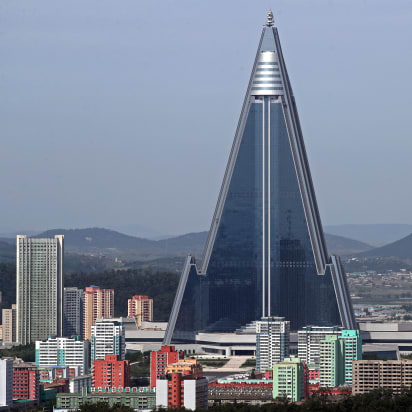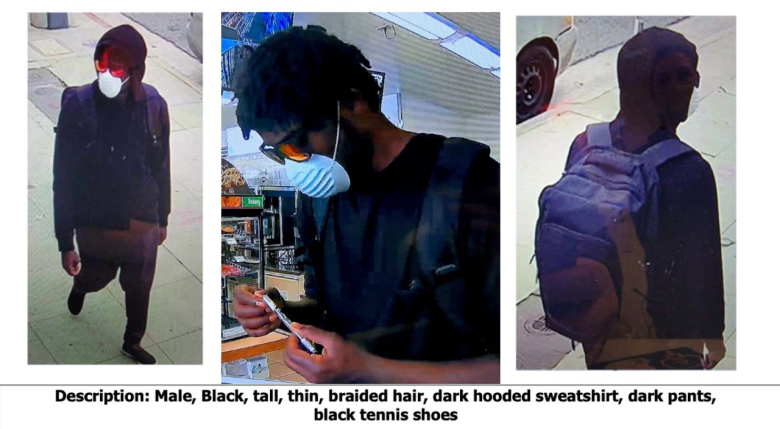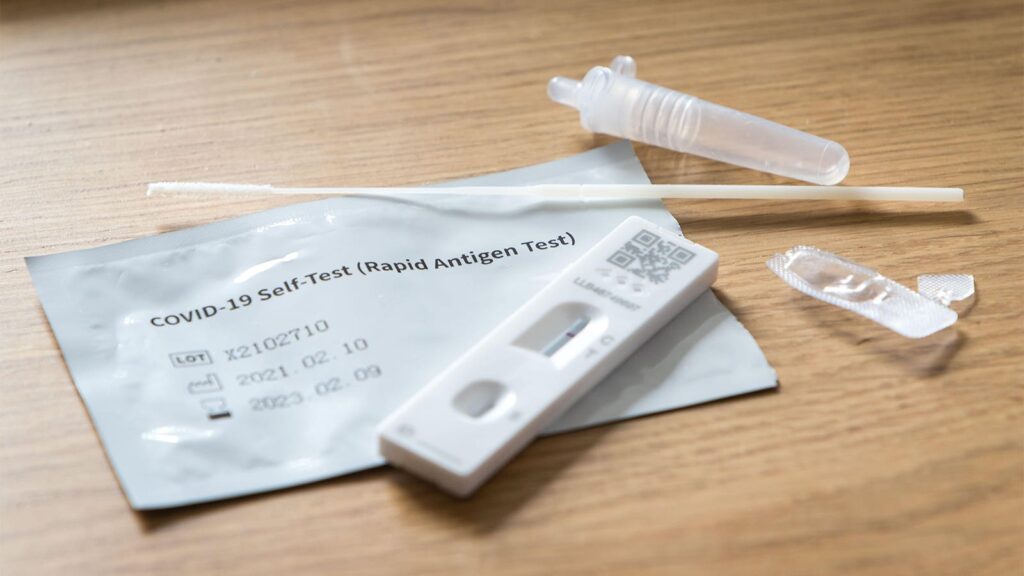The Ryugyong Hotel
The Ryugyong Hotel (also known as the Yu-Kyung Hotel) is an unfinished 105-story, 330-metre-tall (1,080-foot) pyramid-shaped skyscraper in Pyongyang, North Korea. Its name (“capital of willows”) is also one of Pyongyang’s historical names. The building is also known as the 105 Building, a reference to the number of storeys it contains (btw only 21 buildings in the world have 100+ storeys). The structure is intended to be a mixed-use development with a hotel. Guinness World Records presently lists the building as the tallest vacant building in the world.
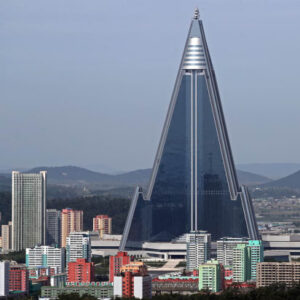
Construction began in 1987 but was halted in 1992 due to North Korea’s economic difficulty following the fall of the Soviet Union. After 1992, the structure was completed but lacked windows and interior amenities. Construction continued in 2008, and the exterior was completed in 2011. The hotel was supposed to open in 2012, on the 100th anniversary of Kim Il-birth. sung’s
Construction began in 1987 but was halted in 1992 due to North Korea’s economic difficulty following the fall of the Soviet Union. After 1992, the structure was completed but lacked windows and interior amenities. Construction continued in 2008, and the exterior was completed in 2011. The hotel was supposed to open in 2012, on the 100th anniversary of Kim Il-birth. sung’s
In 2013, a partial opening was announced, however, it was canceled. In 2018, an LED display was installed on one side to show propaganda animations and film clips.
How It’s Build
The Ryugyong Hotel stands 330 meters (1,080 feet) tall, making it the most visible landmark of Pyongyang’s skyline and North Korea’s highest structure. The Ryugyong Hotel was supposed to be finished in time for President Kim Il-80th Sung’s birthday in 1992; if that goal had been met, it would have been the world’s highest hotel. According to Guinness World Records, it is the world’s highest vacant building.
The structure is made up of three wings, each 100 meters (330 feet) long and 18 meters (59 feet) broad, modestly stepped once but otherwise sloping at 75 degrees to the floor, that converge at a single point to form a pinnacle. The building is capped with a truncated cone 40 meters (130 feet) diameter, consisting of eight rotating stories topped by six static floors.
According to several reports, the structure was initially supposed to accommodate five spinning restaurants and either 3,000 or 7,665 hotel rooms. According to Orascom’s Khaled Bichara in 2009, the Ryugyong will be a mixed-use development featuring “revolving restaurant” amenities as well as a “combination of hotel rooms, apartments, and business facilities.”
According to several reports, the structure was initially supposed to accommodate five spinning restaurants and either 3,000 or 7,665 hotel rooms. According to Orascom’s Khaled Bichara in 2009, the Ryugyong will be a mixed-use development featuring “revolving restaurant” amenities as well as a “combination of hotel rooms, apartments, and business facilities.”
How the construction started
The concept for a huge hotel was reportedly a Cold War response to the South Korean corporation SsangYong Group’s completion of the world’s tallest hotel, the Westin Stamford Hotel in Singapore, in 1986.
The North Korean government saw the initiative as a way for Western investors to enter the market. Ryugyong Hotel Investment and Management was formed in order to attract the hoped-for $230 million in foreign investment.
A North Korean government spokesman promised relaxed control, letting “foreign investors [to] operate casinos, nightclubs, or Japanese lounges.” Baikdoosan Architects & Engineers (also known as Baekdu Mountain Architects and Engineers) of North Korea began building on a pyramid-shaped hotel in 1987.
The hotel was supposed to open in 1992 to commemorate President Kim Il-80th Sung’s birthday, but problems with construction processes and materials delayed completion. If it had opened on time, it would have eclipsed the Westin Stamford to become the world’s tallest hotel, as well as the world’s seventh-tallest building.
Construction pause
Work on the skyscraper was halted in 1992, after it had achieved its full architectural height, due to the North Korean economic crisis that followed the collapse of the Soviet Union.
According to Japanese media, the construction cost $750 million, or 2% of North Korea’s GDP. For more than a decade, the unfinished structure sat empty and devoid of windows, fixtures, or fittings, like a giant concrete shell.
At the top, a rusted construction crane remained, which the BBC described as “a symbol of the authoritarian state’s unfulfilled ambition.” According to Marcus Noland, the European Chamber of Commerce in Korea evaluated the building in the late 1990s and found that it was irreparable.
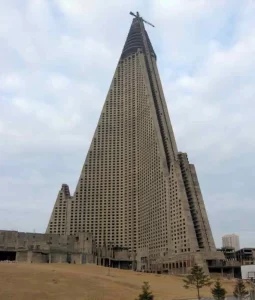
Concerns were raised about the quality of the building’s concrete and the alignment of its elevator shafts, which were described as “crooked” by some sources.
ABC News questioned whether North Korea had the raw materials or energy for such a big undertaking in a 2006 piece. According to a North Korean government official quoted in the Los Angeles Times in 2008, building was halted “because [North Korea] ran out of money.”
Despite the fact that mock-up photographs of the completed hotel appeared on North Korean stamps during the early construction period, the North Korean authorities overlooked the building’s presence during the development pause, despite the fact that it dominated the Pyongyang skyline. The authorities modified official images to remove the incomplete skyscraper from Pyongyang’s skyline and removed it from printed maps of the city.
Because of the development pause, rumors of issues, and uncertainty about its future, foreign media outlets dubbed it “the worst building in the world,” “Hotel of Doom,” and “Phantom Hotel.”
Construction Continuation
The Egyptian construction firm Orascom Group commenced work on the building in April 2008, after it had been dormant for 16 years. The company, which had agreed to a $400 million agreement with the North Korean government to create and operate a 3G cellular network, stated that the telecoms deal was unrelated to the Ryugyong Hotel project.

North Korean officials announced in 2008 that the hotel will be finished by 2012, which would coincide with the 100th anniversary of the birth of the Eternal President Kim Il-sung.
Orascom’s chief operating officer Khaled Bichara stated in 2009 that they “had not had too many problems” correcting the building’s reported structural faults, and that a revolving restaurant would be built at the top of the structure.
The outside construction was reported to be finished in July 2011. Exterior glass panels and telecommunications antennae were installed by Orascom. Koryo Tours revealed images of the interior for the first time in September 2012. There were only a few fixtures and furnishings.
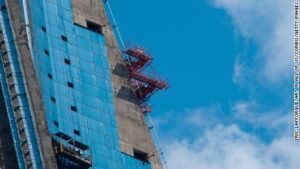
Kempinski interests
Kempinski, an international hotel operator, confirmed in November 2012 that it would manage the hotel, which was set to partially open in mid2013. Plans to open the hotel were put on hold in March 2013. Kempinski revised prior claims, stating that only “initial negotiations” had ever taken place, but no deal had been signed because “market entry is not yet viable.”

Kempinski did not elaborate on its reasons, but commentators speculated that international concerns due to North Korea’s nuclear test in 2013, economic uncertainties, and building delays all played a role.
Current activities
In late 2016, there were signs of fresh activity, including a rumor that an Orascom representative had visited North Korea. There were signs of activity at the site in 2017 and early 2018, with access roads being built.
In April 2018, it was reported that a big LED display depicting the North Korean flag had been installed on the building’s roof.
By May, an LED display had been installed on one entire side of the structure, and the building was said to be ready for occupancy.

By July, the LED display had begun to display animations and movie scenes. Over the main entrance, new signage with the hotel’s name (in Korean and Latin letters) and logo was installed in June 2019.

